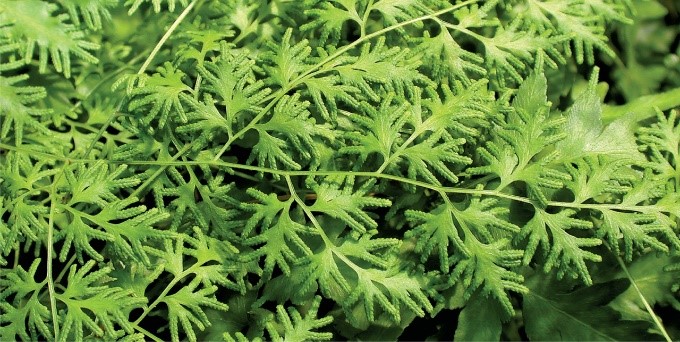This is a publication of HHMI (Howard Hughes Medical Institute) Bio-Interactive about a mutation that has been discovered in the genomes of families with early onset Alzheimers disease. It is a pedigree of a family in Colombia that has a mutated PSEN1.

http://www.atlasobscura.com/articles/some-of-historys-most-beautiful-combs-were-made-for-lice-removal From Atlas Obscura, an exhibit or ornate lice combs. With us from the beginning.

https://alicerosefoxall.wordpress.com/2016/06/26/ferns-communicate-to-determine-their-sexes/ This is an article about research done at Nagoya U on Lygodium japonicum which determined that ferns use gibberellins for sex determination. It is a little bit more complex than this, of course.

http://www.the-scientist.com/?articles.view/articleNo/46416/title/Reverse-Transcriptase-with-Proofreading-Capabilities-Created/ This is a report of research done at U Texas published in Science about the creation of a synthetic reverse transcriptase, a "xenopolymerase", which has proofreading capabilities.

http://washingtonmonthly.com/2016/06/27/is-it-better-to-teach-pure-math-instead-of-applied-math/ From Washington Monthly, is it better to teach pure or applied math? Research from the OECD, Organization for Economic Cooperation and Development say that the richer you are the more likely to learn pure math and not a watered down applied math approach.

http://www.nytimes.com/2016/06/25/science/scales-feathers-hair-common-ancestor.html
From the NYT, a report of research done at the U of Geneva and published in Science Advances about how anatomical structures in bearded dragons, crocodiles and corn snakes all inherited their placodes from the same reptilian ancestor. An embryonic placode in birds and mammals is known to develop into hair. So the ancient reptilian ancestor is the beginning. Drum roll and fanfare.

https://www.sciencedaily.com/releases/2016/06/160627160939.htm Article in Science Daily about Chronic Fatigue Syndrome, the "non-disease". As reported in Microbiome, Cornell U scientists have found biological markers include markers for inflammation in patients with ME/CFS. (I knew it.)

http://www.nature.com/nrg/journal/vaop/ncurrent/full/nrg.2016.59.html The molecular hallmarks of epigenetic control. Not sure this will get you the full article. This is from Nature Reviews Genetics and is a very important topic about environmental influences on genetics.

http://www.eurekalert.org/pub_releases/2016-06/b-cf-fbe062816.php From eurekalert and to be published in Elife, a report of research on Pentagone, why do some stem cells form a finger? It turns out that Dpp and Pentagone are in people too in addition to fruit flies. They may controls what cells form fingers. This work was done at the U of Freiberg.

https://www.sciencebasedmedicine.org/why-science-based-medicine-matters/ This is an article on why science-based medicine matters. We don't need to vaccinate against smallpox anymore but it should be a wake-up call to the anti-vaxxers.

http://scienceblogs.com/insolence/2016/06/28/quackery-expands-in-the-dana-farber-cancer-institute-and-childrens-hospital-of-philadelphia/ Quackery at the Dana Farber and CHOP. This is a Science Blogs from Respectful Insolence article about "integrative Medicine" and acupuncture. It criticizes DFC and CHOP for spending money on "fairy dust".

http://www.sciencemag.org/news/2015/03/your-face-same-age-you-are From Science magazine, published in Cell Research, a facial map was made by taking 3D images of more than 300 faces. They used their map of facial aging to predict the age of each subject. Then they compared blood samples of slow medium and fast agers.

http://www.atlasobscura.com/articles/the-scottish-scoundrel-who-changed-how-we-see-data From Atlas Obscura, an article about William Playfair, inventor of the pie chart.

https://www.sciencedaily.com/releases/2016/06/160629145200.htm From Science Daily a review in PLOS ONE about butter consumption done by Tufts University researchers. The metastudy found small or insignificant association of butter consumption with total mortality, cardiovascular disease, and diabetes.

http://www.smithsonianmag.com/science-nature/this-is-how-your-brain-becomes-addicted-to-caffeine-26861037/ A 2013 commentary from Smithsonian about the effects of regular caffeine consumption on the brain. Yes, it is addictive and chemically resembles the molecule adenosine and binds the receptors for adenosine.

https://www.sciencedaily.com/releases/2016/06/160630144409.htm This is an article from Science Daily reporting a treatment developed at UPenn for autoimmune diseases. They were working on pemphigus vulgaris, a disease I love to say, in which the body makes antibodies to a protein called desmoglein-3. In the treatment, they were able to remove a subset of antibody making cells without interfering with normal immunity. This is published online in Science.

I hope you are enjoying this blog as much as I am enjoying doing it.
http://www.the-scientist.com/?articles.view/articleNo/42280/title/How-We-Age/ From The Scientist, How We Age. This is a commentary from the Scientist Staff sand includes all the multifarious ways, from DNA repair mechanism deterioration to telomere damage.
http://www.the-scientist.com/?articles.view/articleNo/46133/title/Zebra-Finches-Aid-Neurodegeneration-Research/ From The Scientist an article about neurodegeneration and zebra finches (not zebrafish) is about Duke University, U Wisconsin and other researches on the similarities between songbirds' and our own brains. It is actually a review. The most recent work is published in PNAS on mutant huntingtin and singing behavior in songbirds.
http://well.blogs.nytimes.com/2016/06/28/pelvic-exams-may-not-prolong-life-a-task-force-says/ From the NYT Wellness Blog, a new finding from the US Preventative Services Task Force that pelvic exam may not be needed for women. ACOG still recommends the annual exams until there are trials done.

http://www.nytimes.com/2016/07/05/health/what-doctors-know-about-how-bad-it-is-and-wont-say.html Article in the NYT about the discordance between what doctors know and what they say.
This research was done at the Center for Research on End of Life Care at Weill-Cornell Medical Center and published in JAMA.

No comments:
Post a Comment